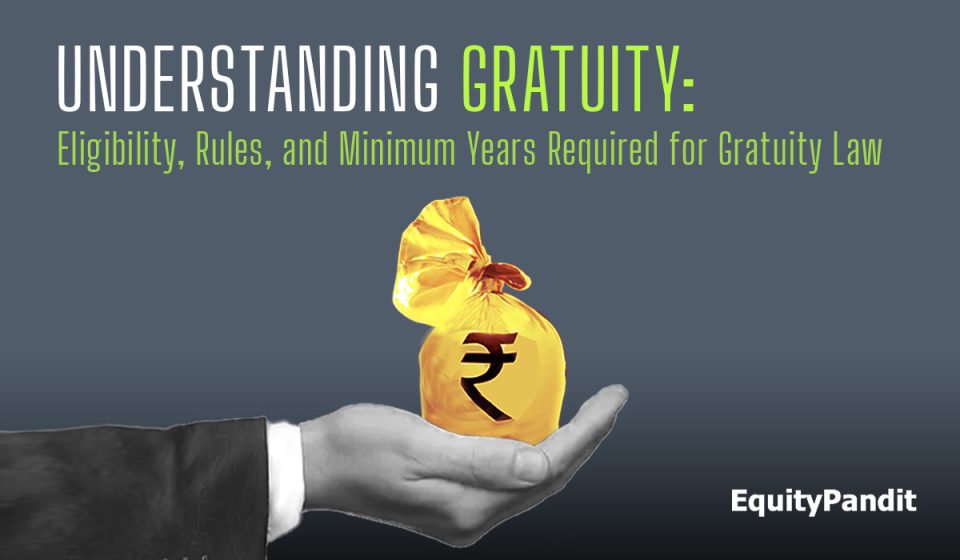What is Gratuity?
The rules of Gratuity payment are governed by the Payment of Gratuity Act 1972 in India. Gratuity is an amount paid by an Employer to its Employees for services provided by the Employees to the company. The benefit of Gratuity is only available to employees who have worked for at least five years.
What are the major areas covered by the Payment of Gratuity Act of 1972 in India?
The Act mainly covers the following areas. These are as follows –
1) Applicability of the Act to different organisations.
2) The eligibility of employees for getting the Gratuity in India.
3) The controlling or governing authority
4) Determination of the amount of Gratuity
5) Nominees of the Employee
6) Inspectors and Power of Inspectors
7)Recovery of Gratuity
8) Penalties for the Employers
What is the eligibility of an Employee to get Gratuity in India?
1) The Employee must have attained superannuation.
2) Employee must have retired from service.
3) The Employee must have completed a minimum of five years of service with the Employer.
4) Employees also become eligible for Gratuity if they suffer disability due to an accident. Or is diagnosed with critical illness.
5) Termination of Employee without the Employee’s fault.
6) Gratuity can also be made available to nominees or family members of the Employee before the completion of five years in the event of their death.
Exceptions to the five-year rule
Employees are eligible for benefits in cases of death or disability regardless of their length of service. Under certain conditions, Employees can meet eligibility criteria with just four years and seven months of service. This is known as the “4 Years 240 Days Rule.”
What is the eligibility of an organisation in India that can provide gratuity payment?
The organisation should have 10 or more employees in the preceding 12 months. This includes factories, mines, oil fields, plantations, ports, railways, and motor transport undertaking shops. It also includes private establishments. Even if the number of employees becomes less than 10 after the Gratuity Act becomes eligible for the first time, Gratuity will still be applicable.
How’s the Gratuity Amount calculated for an Employee in India?
Situation (A)
For Employees covered under the Payment of Gratuity Act as explained below.
Gratuity Formula = (15 * Years Worked * Last Received Salary) / 26
The Last Received Salary comprises Basic Salary and Dearness Allowance (DA). A year of work is counted once six months or more have been completed in that year.
Example:
The Working Period of Mr A is 12 years
Number of working years = 12 years
Last drawn salary = ₹ 80,000
Total Gratuity = 15/26 * 80,000*12 = ₹5,53,846
Situation (B)
For employees not protected by the Act, the formula for calculating Gratuity is a bit different:
Gratuity Formula= (15 * Last Salary Drawn in Last 10 Months * Number of Years Worked) / 30
The Last Salary Drawn includes Basic Salary and Dearness Allowance (DA). Plus, commissions. A full year of work is counted upon completion of each year.
Example:
The Working Period of Mr. B is 12 years
Number of working years = 12 years
Last drawn salary in previous 10 months ₹80000
Total Gratuity = 15/30 * 80,000*12 = ₹4,80,000
New Rules Related to Payment of Gratuity Act in India
The Ministry of Labour and Employment has finalised new gratuity payment regulations 2024 under the Four Labour Code. The new law’s implementation date is April 1st, 2021. Experts anticipate that organisations must adjust their costs to the company (CTC), including allowances, to comply with the new law.
Organisations must ensure that at least 50% of an employee’s salary constitutes basic pay. Employers may need to restructure the salary package when an Employee’s basic pay falls below 50% to adhere to new gratuity rules under the four labour codes. An employee’s basic pay increase will result in a proportionate rise in gratuity payments.
The new definition specifies that salaries should exclude bonuses. Also, pension contributions, provident fund contributions, house rent allowances, conveyance allowances, gratuities and overtime are not included.
Many experts predict the new law will significantly impact salary structures. Social security deductions, such as provident fund contributions, are expected to rise, decreasing employees’ take-home pay.
What is the Gratuity limit in India?
For Central Government employees
The Ministry of Personnel Public Grievances and Pensions, Government of India, will increase the maximum retirement and death gratuity limit by 25% whenever dearness allowance rises by 50% of the basic pay. Consequently, the maximum retirement and death gratuity limit will be raised by 25% to Rs. 25 Lakh from the current Rs 20 Lakh. This is due to the revision of Dearness Allowance for Central Government Employees to 50% of basic pay effective from 1.01.2024. This is subject to other conditions specified in the office memorandum dated 04.08.2016.
For other than Central Government Employees:
For other employees, the maximum limit of total gratuity payment attained on the maturity date is Rs 20 lakhs.
What are Taxation Regulations for Gratuity?
The tax implications of gratuity sum depend on the category of Employee entitled to receive it.
It’s crucial to emphasise that the complete gratuity amount received by a government employee, regardless of whether from central, state, or local authority, is free from income tax.
Any other qualifying private employee whose Employer falls under the Payment of Gratuity Act. In this case, the smallest of the following three amounts will be exempt from income tax.
a) The eligible Gratuity.
b) The actual gratuity amount received.
c) Rs 20 lakh.
Frequently Asked Questions (FAQs)
1.What is Superannuation?
The term superannuation means retirement because of age or infirmity. Many employers in India are supposed to give superannuation benefits to their employees upon retirement. Benefits like pension plans and gratuities are all given upon retirement based on the fulfillment of certain criteria.
2.Is the Employer obliged to pay a gratuity to its employees if the organisation goes bankrupt?
Yes. In a bankruptcy situation, the Employer should also pay the Gratuity to employees if they are eligible.
3.How much tax can be exempt from the gratuity payment received?
Employee gratuity is deducted under section 10(10) of the Income Tax Act, 1961. The tax amount up to which exemption can be prevailed is up to Rs 20 lakhs, up from the previous exemption limit of up to Rs 10 lakhs.
4.What is the payment time in which the gratuity amount is paid to an employee?
Gratuity payment should be made payable to an employee within 30 days of the amount being eligible to be paid to an employee.
5.Is the gratuity amount payable to an employee upon layoff?
Yes, it can be payable after layoff, if the employee fits into the eligibility criteria as per the payment of gratuity rules, and layoff is not because of the employee’s fault.
6.Does the gratuity amount come under your CTC?
No. Gratuity doesn’t come under an employee’s CTC. Gratuity is paid as a gesture of gratitude, thanksgiving, or appreciation given to an employee in exchange for services offered by him/her.







